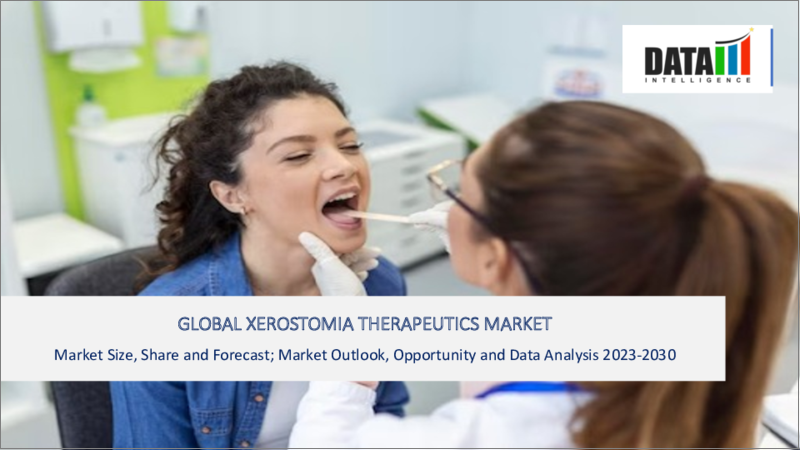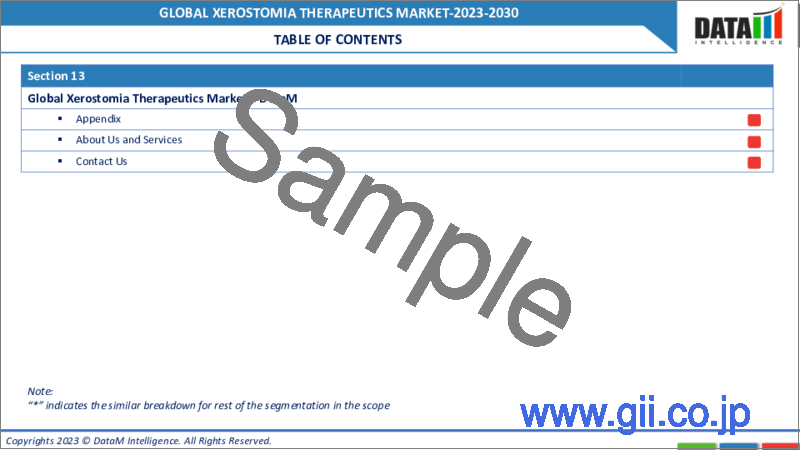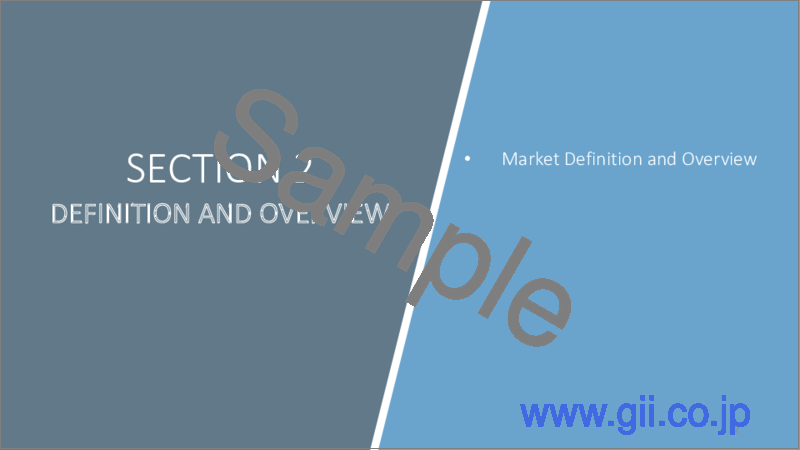|
|
市場調査レポート
商品コード
1138364
口腔乾燥症治療薬の世界市場-2022-2029年Global Xerostomia Therapeutics Market - 2022-2029 |
||||||
|
● お客様のご希望に応じて、既存データの加工や未掲載情報(例:国別セグメント)の追加などの対応が可能です。 詳細はお問い合わせください。 |
|||||||
| 口腔乾燥症治療薬の世界市場-2022-2029年 |
|
出版日: 2022年10月18日
発行: DataM Intelligence
ページ情報: 英文 200 Pages
納期: 約2営業日
|
- 全表示
- 概要
- 目次
市場力学
口腔乾燥症治療薬市場の成長は、化学療法の増加、認知度の向上、口腔乾燥症および関連疾患の有病率の上昇など、いくつかの要因によって推進されています。
口腔乾燥症と関連疾患の有病率の増加は、口腔乾燥症治療薬の需要を増加させ、市場の成長を促進しています。
口腔乾燥症や高血圧、パーキンソン病、シェーグレン症候群、糖尿病などの関連疾患の発生が増加していることは、市場の成長にプラスの影響を与えています。糖尿病は、ドライマウスの原因となる主要な原因の一つであり、体が尿を作るために流体を使用しているときに他のものために少ない水分がある、これは糖尿病で発生します。糖尿病は、それゆえ、脱水状態の身体と、乾燥を感じる口内につながります。口腔乾燥は、糖尿病の副作用を悪化させ、グルコースレベルを上昇させ、体に大混乱をもたらす可能性があります。特に糖尿病患者の場合、口腔乾燥があると、虫歯の多発につながります。これは、体が感染と戦おうとして血糖値が上昇することを意味します。また、口の中が乾燥すると、睡眠不足や味覚の変化(口の中に金属や酸っぱい味がする)を引き起こす可能性もあります。
口腔乾燥は、高齢者によく見られる症状です。高齢者の口腔乾燥の約40%の根本的な原因はシェーグレン症候群であるとする研究報告があります。シェーグレン症候群は、リウマチの自己免疫疾患の中で3番目に多い疾患です。シェーグレン症候群の人口有病率は0.2%で、発症率は年間10万人あたり4例です。シェーグレン症候群は、男性よりも女性に20倍多くみられます。シェーグレン症候群は、涙や唾液を作る腺を攻撃するため、口の渇きや目の渇きを引き起こし、口腔乾燥症の症例が増加します。
高いコスト、薬物の副作用の可能性、および厳しい規制が、世界の口腔乾燥症治療薬市場成長の減点理由となるでしょう。
口腔乾燥症の利用可能な治療法の高コスト、効果のなさ、一般的でない副作用は、世界の口腔乾燥症治療薬市場の成長を抑制しています。また、医薬品承認に関する米国食品医薬品局(FDA)の厳しい規制が、市場の成長を阻害する可能性があります。例えば、Ethyolという商品名で販売されているAmifostineは、放射線誘発性口腔乾燥症を保護するために米国FDAによって検証された唯一の利用可能な薬物です。
産業分析。
世界の口腔乾燥症治療薬市場レポートは、Porter`s Five forces、研究開発、疫学、規制、価格、パイプライン分析など、さまざまな業界要因に基づく市場の詳細な分析を提供する予定です。
COVID-19の影響分析
パンデミックにおいて、COVID-19の拡散を制限するために多くの制限が課されたため、世界市場はマイナスの影響を受け、需給チェーンが混乱し、口腔乾燥症の治療薬の売上を減少させました。さらに、社会化規制により定期的な健康診断を受けることが難しく、ほとんどの口腔乾燥症患者が未検出となり、世界の口腔乾燥症治療薬市場にマイナスの影響を及ぼしています。
世界の口腔乾燥症治療薬市場レポートでは、約40以上の市場データ表、45以上の図、200ページ(概算)の範囲でのアクセスを提供することになります。
目次
- 調査手法
- 調査目的および調査範囲
第2章 市場の定義と概要
第3章 エグゼクティブサマリー
第4章 市場の力学
- 市場影響要因
- 促進要因
- 口腔乾燥症と関連疾患の症例数の増加
- 研究開発の進展
- 市場戦略
- 抑制要因
- 薬剤の副作用
- 厳しい規制機関
- ビジネスチャンス
- 影響分析
- 促進要因
第5章 産業分析
- ポーターのファイブフォース分析
- 疫学分析
- 研究と開発
- パイプライン分析
- サプライチェーン分析
- 規制分析
第6章 COVID-19の分析
- COVID-19の市場分析
- COVID-19以前の市場シナリオ
- COVID-19の現在の市場シナリオ
- COVID-19の後、または将来のシナリオ
- COVID-19の中での価格ダイナミクス
- 需要-供給スペクトラム
- パンデミック時の市場に関連する政府の取り組み
- メーカーの戦略的取り組み
- まとめ
第7章 タイプ別
- 一般用医薬品
- 処方薬
第8章 製品タイプ別
- 唾液分泌促進剤
- 代用唾液
- 歯科用剤
- 人工唾液
- 唾液腺ペン
第9章 販売チャネル別
- 病院内薬局
- 小売薬局
- オンライン薬局
第10章 地域別
- 北米
- 米国
- カナダ
- メキシコ
- 欧州
- ドイツ
- 英国
- フランス
- イタリア
- スペイン
- その他欧州
- 南米
- ブラジル
- アルゼンチン
- その他の南米地域
- アジア太平洋地域
- 中国
- インド
- 日本
- オーストラリア
- その他アジア太平洋地域
- 中東・アフリカ地域
第11章 競合情勢
- 主な展開と戦略
- 企業シェア分析
- 製品ベンチマーク
第12章 企業プロファイル
- Daiichi Sankyo Company
- 企業概要
- 製品ポートフォリオと説明
- 主なハイライト
- 財務概要
- GlaxoSmithKline
- Church & Dwight Co., Inc.
- Colgate-Palmolive Company
- Acacia Pharma Group plc
- Hikma Pharmaceuticals plc
- Lupin Ltd.
- Parnell Pharmaceuticals Inc.
- Pendopharm, Virginia Head and Neck Therapeutics, Inc.
- Pfizer Inc. and
- Sun Pharmaceutical Industries Ltd
第13章 DataM
Market Overview
Xerostomia Therapeutics Market size was valued at US$ YY million in 2021 and is estimated to reach US$ YY million by 2029, growing at a CAGR of 3.8% during the forecast period (2022-2029).
Xerostomia is defined as dry mouth resulting from reduced or absent saliva flow. Xerostomia is not a disease but is a symptom of toxicity from chemotherapy, head and neck radiotherapy, adverse effects of medications, autoimmune disease, or other conditions such as uncontrolled diabetes, infections, and hormonal changes. Xerostomia occurs commonly in those with Sjogren disease or who are receiving radiation therapy for head and neck cancer. Xerostomia is a common complaint among older adults, affecting approximately 20% of the elderly. Reduced salivary flow can cause difficulties in tasting, chewing, swallowing, and speaking; it can also increase the chance of developing dental decay, demineralizing teeth, tooth sensitivity, and oral infections.
Market Dynamics
The xerostomia therapeutics market growth is driven by several factors, such as an increase in chemotherapy, growing awareness and rising prevalence of xerostomia and associated diseases.
The growing prevalence of xerostomia and associated diseases has increased the demand for xerostomia therapeutics fueling the market growth.
The growing occurrence of xerostomia and related diseases such as hypertension, Parkinson's disorder, Sjogren's syndrome and diabetes positively impact market growth. Diabetes is one of the major causes that causes of dry mouth; there is less moisture for other things when the body is using fluids to make urine, which happens in diabetes. Diabetes hence leads to a dehydrated body and mouth that feels dry. Xerostomia can exacerbate the side effects of diabetes, increasing glucose levels and wreaking havoc on the body. Having xerostomia, especially as a diabetes patient, can lead to rampant tooth decay, which means blood sugar increases as the body tries to fight infection. A dry mouth can also lead to loss of sleep and an altered sense of taste, a condition that presents a metallic or sour taste in the mouth.
Xerostomia is a common symptom in the elderly population. Studies have suggested that the underlying cause of approximately 40% of xerostomia in the elderly is Sjogren's syndrome. Sjogren's syndrome is the third most common rheumatic autoimmune disorder. The population prevalence of Sjogren's syndrome is 0.2%, with an incidence of 4 cases per 100,000 per year. Sjogren's is 20 times more common in females than males. Sjogren's syndrome attacks the glands that make tears and saliva; this causes a dry mouth and dry eyes, increasing the cases of xerostomia.
The high cost, chances of drug side effects and stringent regulations will be the demoting reasons for the global xerostomia therapeutics market growth.
The High cost, ineffectiveness and common and uncommon side effects of available treatments for xerostomia are restraining the growth of the global xerostomia therapeutics market. In addition, stringent U.S. Food and Drug Administration (FDA) regulations for drug approval can hamper market growth. For instance, Amifostine-sold under the trade name Ethyol is the only drug available validated by the U.S FDA for protecting radiation-induced xerostomia.
Industry analysis.
The global xerostomia therapeutics market report will provide an in-depth analysis of the market based on various industry factors such as porter`s five forces, research and developments, epidemiology, regulatory, pricing, and pipeline analysis.
COVID-19 Impact Analysis
In the pandemic, the global market was negatively affected as many restrictions were imposed to limit the COVID-19 spread, which led to the disruption of the supply and demand chain, reducing the sales of the Xerostomia therapeutics. Furthermore, the socializing restriction made it difficult to get regular healthcare checkups, leaving most Xerostomia patients undetected, negatively impacting the global Xerostomia therapeutics market.
Segment Analysis
Salivary stimulants are presumed to be prevailing throughout the forecast period (2022-2029)
Salivary stimulants are expected to be the largest market shareholder over the period forecast (2022-2029). Topical salivary stimulant flow products include over-the-counter sugar-free gums, mints, and candies. Salivary stimulants include the sialagogues pilocarpine hydrochloride (Salagen®) and cevimeline hydrochloride (Evoxac®). Pilocarpine and cevimeline bind to muscarinic receptors, stimulating exocrine gland activity (such as salivary and sweat glands) and increasing smooth muscle tone in the gastrointestinal and urinary tracts. Common adverse effects include sweating, headache, GI discomfort, nausea, increased lacrimation, urinary frequency, and palpitations. Sialogogic drugs are substances designed to stimulate salivary secretion as they affect the systemic pathway. Using sugar-free chewing gum or tablet can increase salivary secretion and improve the sensation of dry mouth with gustatory and masticatory stimulation. These products include fluoride, chlorhexidine, calcium phosphate, and xylitol releasers. Salivary stimulants are highly popular as they are readily available and can be taken without adverse effects.
Geographical Analysis
The North American region is overshadowing the global xerostomia therapeutics market.
North America was dominating the xerostomia therapeutics market in 2021. It is estimated to hold the largest market size over the forecast period (2022-2029), owing to an increase in cancer and xerostomia-associated disorders such as Sjogren's disorder, a highly aware population, advanced healthcare infrastructure, favorable government initiatives and growth in research and development. As per the National Cancer Institute, in 2020, around 1,806,590 new cancer cases were diagnosed in the US, and 606,520 people died. These numbers increase yearly, along with the causes such as lifestyle changes, smoking, etc. The US is very advanced in healthcare, and the population is generally aware; this leads to growing chemotherapy treatment cases leading to xerostomia.
Similarly, other diseases associated with xerostomia, such as Parkinson's and Sjogren's syndrome, are also on the rise in the region; Sjogren's occurs in 0.1 to 1 percent of the population and is one of the most prevalent autoimmune diseases. Nine out of 10 patients are women. Initiatives launched by various organizations, such as the "5-year breakthrough goal" by Sjogren's Syndrome Foundation, focus on faster diagnosis and better treatment.
Competitive Landscape
Some of the major key players in the market are GlaxoSmithKline, Church & Dwight Co., Inc., Colgate-Palmolive Company, Acacia Pharma Group plc, Hikma Pharmaceuticals plc, Lupin Ltd., Parnell Pharmaceuticals Inc., Pendopharm, Virginia Head and Neck Therapeutics, Inc., Pfizer Inc. and Sun Pharmaceutical Industries Ltd. In the xerostomia therapeutics market, GlaxoSmithKline will dominate the market, owning to portfolio expansion, mergers, collaborations, and acquisitions. The key players are adopting various growth strategies such as mergers & acquisitions, partnerships, and collaborations and increasing research and development and high investment, contributing to the growth of the global xerostomia therapeutics market. For instance, on February 11, 2021, Virginia Head and Neck Therapeutics, Inc. introduced the Voutia device, which provides continuous relief from xerostomia.
Daiichi Sankyo Company
Overview
Daiichi Sankyo Company, Limited is a leading global pharmaceutical company and is the second-largest pharmaceutical company in Japan. As of March 2020, it has 15,348 employees. Daiichi Sankyo Company was founded in 2005 and is headquartered in Tokyo, Japan.
Product Portfolio
Daiichi Sankyo Company's xerostomia product portfolio has Evoxac.
The global xerostomia therapeutics market report would provide access to approximately 40+ market data tables, 45+ figures, and in the range of 200 (approximate) pages.
Table of Contents
Methodology and Scope
- 1.1. Research Methodology
- 1.2. Research Objective and Scope of the Report
2. Market Definition and Overview
3. Executive Summary
4. Market Dynamics
- 4.1. Market Impacting Factors
- 4.1.1. Drivers
- 4.1.1.1. Growing Cases Growing Prevalence of Xerostomia And Associated Diseases
- 4.1.1.2. Research and Development
- 4.1.1.3. Market Strategies
- 4.1.2. Restraints
- 4.1.2.1. Drug Side Effects
- 4.1.2.2. Stringent Regulatory Bodies
- 4.1.3. Opportunity
- 4.1.4. Impact Analysis
- 4.1.1. Drivers
5. Industry Analysis
- 5.1. Porter's Five Forces Analysis
- 5.2. Epidemiological Analysis
- 5.3. Research and Developments
- 5.4. Pipeline Analysis
- 5.5. Supply Chain Analysis
- 5.6. Regulatory Analysis
6. COVID-19 Analysis
- 6.1. Analysis of Covid-19 on the Market
- 6.1.1. Before COVID-19 Market Scenario
- 6.1.2. Present COVID-19 Market Scenario
- 6.1.3. After COVID-19 or Future Scenario
- 6.2. Pricing Dynamics Amid Covid-19
- 6.3. Demand-Supply Spectrum
- 6.4. Government Initiatives Related to the Market During Pandemic
- 6.5. Manufacturer's Strategic Initiatives
- 6.6. Conclusion
7. By Type
- 7.1. Introduction
- 7.1.1. Market Size Analysis, and Y-o-Y Growth Analysis (%), By Type Segment
- 7.1.2. Market Attractiveness Index, By Type Segment
- 7.2. OTC
- 7.2.1. Introduction
- 7.2.2. Market Size Analysis, US$ Million, 2021-2029 and Y-o-Y Growth Analysis (%), 2021-2029
- 7.3. Prescription
8. By Product Type
- 8.1. Introduction
- 8.1.1. Market Size Analysis, and Y-o-Y Growth Analysis (%), By Product Type Segment
- 8.1.2. Market Attractiveness Index, By Product Type Segment
- 8.2. Salivary Stimulants
- 8.2.1. Introduction
- 8.2.2. Market Size Analysis, US$ Million, 2021-2029 and Y-o-Y Growth Analysis (%), 2021-2029
- 8.3. Salivary Substitutes
- 8.4. Dentifrices
- 8.5. Artificial Saliva
- 8.6. Salivary Pen
9. By Distribution Channels
- 9.1. Introduction
- 9.1.1. Market Size Analysis, and Y-o-Y Growth Analysis (%), By Distribution Channels Segment
- 9.1.2. Market Attractiveness Index, By Distribution Channels Segment
- 9.2. Hospital Pharmacies
- 9.2.1. Introduction
- 9.2.2. Market Size Analysis, US$ Million, 2021-2029 and Y-o-Y Growth Analysis (%), 2021-2029
- 9.3. Retail Pharmacies
- 9.4. Online Pharmacies
10. By Region
- 10.1. Introduction
- 10.1.1. Market Size Analysis, US$ Million, 2021-2029 and Y-o-Y Growth Analysis (%), 2021-2029, By Region
- 10.1.2. Market Attractiveness Index, By Region
- 10.2. North America
- 10.2.1. Introduction
- 10.2.2. Key Region-Specific Dynamics
- 10.2.3. Market Size Analysis, and Y-o-Y Growth Analysis (%), By Type
- 10.2.4. Market Size Analysis, and Y-o-Y Growth Analysis (%), By Product Type
- 10.2.5. Market Size Analysis, and Y-o-Y Growth Analysis (%), By Distribution Channel
- 10.2.6. Market Size Analysis, and Y-o-Y Growth Analysis (%), By Country
- 10.2.6.1. The U.S.
- 10.2.6.2. Canada
- 10.2.6.3. Mexico
- 10.3. Europe
- 10.3.1. Introduction
- 10.3.2. Key Region-Specific Dynamics
- 10.3.3. Market Size Analysis, and Y-o-Y Growth Analysis (%), By Type
- 10.3.4. Market Size Analysis, and Y-o-Y Growth Analysis (%), By Product Type
- 10.3.5. Market Size Analysis, and Y-o-Y Growth Analysis (%), By Distribution Channel
- 10.3.6. Market Size Analysis, and Y-o-Y Growth Analysis (%), By Country
- 10.3.6.1. Germany
- 10.3.6.2. The U.K.
- 10.3.6.3. France
- 10.3.6.4. Italy
- 10.3.6.5. Spain
- 10.3.6.6. Rest of Europe
- 10.4. South America
- 10.4.1. Introduction
- 10.4.2. Key Region-Specific Dynamics
- 10.4.3. Market Size Analysis, and Y-o-Y Growth Analysis (%), By Type
- 10.4.4. Market Size Analysis, and Y-o-Y Growth Analysis (%), By Product Type
- 10.4.5. Market Size Analysis, and Y-o-Y Growth Analysis (%), By Distribution Channel
- 10.4.6. Market Size Analysis, and Y-o-Y Growth Analysis (%), By Country
- 10.4.6.1. Brazil
- 10.4.6.2. Argentina
- 10.4.6.3. Rest of South America
- 10.5. Asia Pacific
- 10.5.1. Introduction
- 10.5.2. Key Region-Specific Dynamics
- 10.5.3. Market Size Analysis, and Y-o-Y Growth Analysis (%), By Type
- 10.5.4. Market Size Analysis, and Y-o-Y Growth Analysis (%), By Product Type
- 10.5.5. Market Size Analysis, and Y-o-Y Growth Analysis (%), By Distribution Channel
- 10.5.6. Market Size Analysis, and Y-o-Y Growth Analysis (%), By Country
- 10.5.6.1. China
- 10.5.6.2. India
- 10.5.6.3. Japan
- 10.5.6.4. Australia
- 10.5.6.5. Rest of Asia Pacific
- 10.6. Middle East and Africa
- 10.6.1. Introduction
- 10.6.2. Key Region-Specific Dynamics
- 10.6.3. Market Size Analysis, and Y-o-Y Growth Analysis (%), By Type
- 10.6.4. Market Size Analysis, and Y-o-Y Growth Analysis (%), By Product Type
- 10.6.5. Market Size Analysis, and Y-o-Y Growth Analysis (%), By Distribution Channel
11. Competitive Landscape
- 11.1. Key Developments and Strategies
- 11.2. Company Share Analysis
- 11.3. Product Benchmarking
12. Company Profiles
- 12.1. Daiichi Sankyo Company
- 12.1.1. Company Overview
- 12.1.2. Product Portfolio and Description
- 12.1.3. Key Highlights
- 12.1.4. Financial Overview
- 12.2. GlaxoSmithKline
- 12.3. Church & Dwight Co., Inc.
- 12.4. Colgate-Palmolive Company
- 12.5. Acacia Pharma Group plc
- 12.6. Hikma Pharmaceuticals plc
- 12.7. Lupin Ltd.
- 12.8. Parnell Pharmaceuticals Inc.
- 12.9. Pendopharm, Virginia Head and Neck Therapeutics, Inc.
- 12.10. Pfizer Inc. and
- 12.11. Sun Pharmaceutical Industries Ltd
LIST NOT EXHAUSTIVE
13. DataM
- 13.1. Appendix
- 13.2. About Us and Services
- 13.3. Contact




